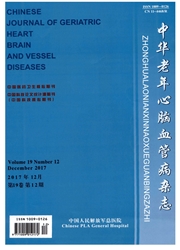

 中文摘要:
中文摘要:
目的 探讨灯盏花素对大鼠局灶性脑缺血再灌注性损伤的保护作用及机制。方法 选择健康成年雄性SD大鼠40只,随机分为4组:假手术组;生理盐水组:生理盐水+大脑中动脉栓塞;硫酸镁组:硫酸镁+大脑中动脉栓塞;灯盏花素组:灯盏花素75mg/kg+大脑中动脉栓塞,每组10只。3、7、14d采用Longa评分、圆筒实验对各组大鼠进行神经功能评分;TTC染色测量脑梗死体积比以及干湿称重法测量脑组织含水量;免疫荧光染色法检测缺血脑组织半胱氨酸天冬氨酸蛋白酶3(caspase-3)阳性细胞表达。结果 灯盏花素组大鼠3、7d神经功能评分脑组织含水量明显低于生理盐水组和硫酸镁组,3、7、14d脑梗死体积百分比和caspase-3阳性细胞表达明显低于生理盐水组和硫酸镁组,差异有统计学意义(P〈0.05)。灯盏花素组3、7、14d圆筒实验前肢使用不对称性改善明显优于生理盐水组和硫酸镁组[(37.60±6.54)分vs(60.28±7.26)分、(58.56±5.61)分,(12.64±2.67)分vs(52.67±2.86)分、(39.63±5.06)分,(7.62±5.30)分vs(30.33±2.16)分、(30.73±5.64)分,P〈0.05]。结论 灯盏花素注射液可显著减少缺血再灌注脑损伤体积,减轻脑水肿,抑制caspase-3表达,显著改善脑缺血后神经功能损伤。
 英文摘要:
英文摘要:
Objective To study the protective effect of breviscapine on cerebral ischemia/reperfusion (I/R) injury in rats. Methods Forty SD rats were randomly divided into sham operation group,norrnal saline (NS) treatment group (NS + MCAO), magnesium sulfate treatment group (magnesium sulfate + MCAO), and breviscapine treatment group (breviscapine 75 mg/kg + MCAO),10 in each group. Their neurological function was scored according to Longa occlusion and cylinder test. The infarction size was measured with TTC staining,the water volume in brain tissue was assayed by dry-wet weighing, and the expression of caspase-3 positive cells in ischemic brain tissue was detected with immunohistochemical staining on days 3,7 and 14 after treatment. Results The neurological function score and water volume in brain tissue were significantly higher while the infarction size and expression level of easpase-3 positive cells were significantly lower in breviseapine treatment group than in NS treatment group and magnesium sulfate treatment group on days 3,7 and 14 after treatment (P〈0.05). Cylinder test showed that the score of asymmetrical upper extremities was significantly lower in breviseapine treatment group than in NS treatment group and magnesium sulfate treatment group on days 3,7 and 14 after treatment (P〈 0.05). Conclusion Breviscapine injection can effectively improve the neurological function in rats after ischemic stroke by reducing the cerebral I/R injury, alleviating the cerebral edema, and downregulating the caspase-3 expression.
 同期刊论文项目
同期刊论文项目
 同项目期刊论文
同项目期刊论文
 期刊信息
期刊信息
